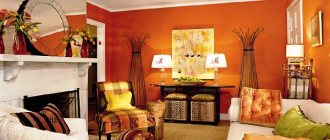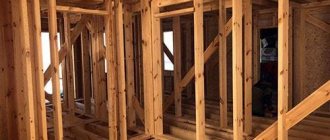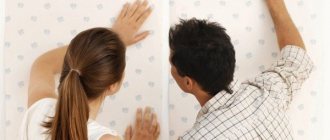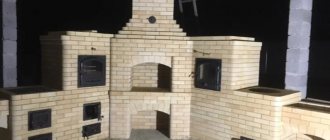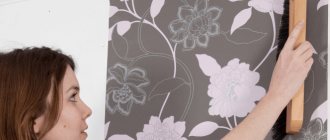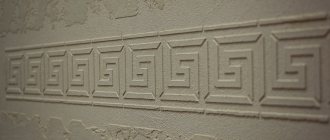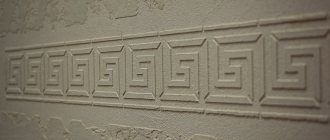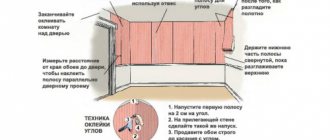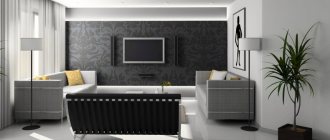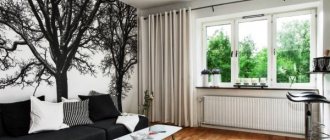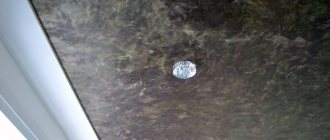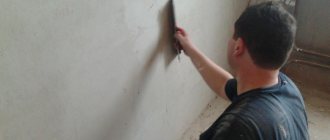Thanks to a fairly large selection, you can turn each room into a work of art, select the most suitable textures and shades, and transform the space through a number of interesting effects of such materials.
A characteristic feature of wallpaper for decorative plaster can be considered the possibility of application even in modern design trends.
Look at the photo of wallpaper under plaster - and make sure that this material looks harmonious in interiors with different design styles compared to standard plaster finishes, which is valuable when it is necessary to maintain a luxurious appearance of the interior.
Combining wallpaper with other finishing materials
The special microclimate of the hallway dictates the design of absolutely all surfaces.
The risk of exposure to moisture and dirt on vertical surfaces prompts many owners to combine wallpaper with other finishing materials. Most often, wall panels are used in the lower part of the walls (they are easy to wash, you can use cleaning products), and in the upper segment you can glue wallpaper of any composition. In addition to practicality, this approach allows you to introduce color and texture diversity into the design of utilitarian premises. Wallpaper can be combined not within the same surface, but canvases and other finishing materials can be used for different planes. You can combine wallpaper with:
- decorative plaster;
- painting:
- liquid wallpaper;
- artistic painting;
- wall panels.
You can combine different types of wallpaper within one utilitarian room. For example, in a corridor or hallway you can create an accent surface by using canvases that differ in color or texture (and sometimes technological properties) from the main finishing material
As a result, you can not only get color variety in the interior of the auxiliary space, but also draw attention to the most successful areas, distract the eye from flaws in the architecture or decoration
Originality for a long time
To all the advantages of decorating a room with beige wallpaper, you can add one more point. Due to the friendliness of beige to other colors and shades, it is sometimes possible to introduce new tones into the interior, making it more fashionable.
At the same time, the perception of the situation will not deteriorate, and the room will remain stylish, original and modern at all times.
What is “Venetian” wallpaper?
General information
Venetian plaster is also called liquid marble, since its composition includes marble flour, sometimes malachite or granite, in addition, the composition contains slaked lime and resins. The coating is applied in several layers, resulting in a special texture and beautiful color shifts.
It should be noted that the high price of such finishing is associated not only with the use of expensive components in the plaster, but also with the complexity of its application. Therefore, even if you buy the mixture, you are unlikely to be able to apply it correctly yourself.
Venetian plaster
However, this is not a reason to refuse such wall decoration. An excellent alternative to natural “Venetian” is wallpaper that imitates this coating. They are made of vinyl applied to non-woven or paper fabric.
It must be said that the vinyl layer is quite thick, thanks to which it reliably imitates the multi-layer structure of Venetian plaster with its iridescence of colors and unusual texture.
Advantages
Of course, in addition to their attractive appearance, such wallpapers also have other advantages:
- the cost is much cheaper than natural plaster - from 1500 to 5000 per roll, depending on the manufacturer;
- You can glue the canvases yourself;
- the coating is moisture resistant - non-woven fabrics can be washed with a damp sponge and detergents;
- The vinyl top layer is UV resistant so it won't fade;
- have dust-repellent properties;
- are quite wear-resistant and durable;
- a large selection of colors, which allows you to choose canvases for any interior.
An example of using “Venetian” wallpaper in different colors
As for the disadvantages, these include the high cost compared to other types of wallpaper. However, given the durability of this coating, good performance and impressive appearance, this price is completely justified.
Wallpaper Grandeco
Relief imitation
It is no secret that the living room is considered the main room in modern apartments. Here the whole family gathers around the TV after working days to relax. It is in the hall that guests are received on holidays. Therefore, the design of the room must be appropriate and meet all the necessary requirements. The use of embossed wallpaper will be a more than successful solution in this case. And the main thing you should pay attention to is the correct choice of color. It is best to give preference to bright shades that will match the overall interior of the room without disturbing the coziness and comfort. The embossed wallpaper in the living room can be seen in this photo:
Important! The background of the hall can be made bright only when the room is spacious and has sufficient lighting.
Stylized walls are great for a fireplace, as well as for an area with a balcony. In the case where there is no balcony or fireplace in the room, you can use embossed wallpaper to decorate one of the free walls, matching it with furniture and other decorative elements. Well suited for the hall inserting imitation Venetian plaster.
To achieve a dynamic effect and give the room brightness and cheerfulness, you can combine relief coverings with other types of wallpaper.
But they also find their use in situations such as:
- lack of funds, forcing you to choose the cheapest materials;
- decorating a children's room when there is no point in gluing up expensive wallpaper, which will inevitably be spoiled quite quickly.
More expensive types of wallpaper using new materials last much longer - up to 8-12 years.
In construction supermarkets you can find wallpaper of any color, texture and pattern. But a modern person, already somewhat tired of the fast pace of life, often wants to see his home decorated in a calmer, or better yet, natural or rustic style. In such an environment you can relax better. Moreover, rest is necessary not only for the soul and body, but also for the eyes, which all day long are forced to strain from the flickering of monitor screens, telephones, and advertising.
Therefore, many people are currently choosing materials that imitate ordinary (or unusual) plaster for wall decoration.
Surfaces finished in this way are most often painted in calm tones, devoid of bright patterns and spots that attract attention and strain the visual apparatus. But at the same time, they do not look boring, they provide an opportunity to show imagination and creativity, and combine well with other finishing materials.
Most often, wallpaper imitates decorative plaster, which is very popular at the moment, but quite expensive. In addition, not everyone is able to apply it to the walls themselves, but almost anyone who knows how to hold a tape measure, scissors and a brush can hang wallpaper. As for the cost, decorating walls with wallpaper will cost several times less than plastering them with decorative compounds.
Recommendations for coloring
You can do any interior finishing work yourself. In addition to saving money, there is no doubt about future results.
Advice When painting wallpaper you need to be careful and careful. There is no need to use more than three colors, paint using similar and pre-selected shades.
Using construction tape you can achieve beautiful borders. Instead, you can use mosaics, paper borders, moldings or wooden slats.
When buying paint, it is advisable to perform calculations and add about 30% to the result obtained. This must be done when tinting the paint and again obtaining the same shade.
Product with texture
To glue wallpaper for painting, you need to prepare the necessary tools and materials:
- roller;
- brushes;
- construction tape.
When choosing paint, you need to take into account the characteristics of some building materials.
For example, water-based paint is suitable for paper coverings and non-woven wallpaper. Acrylic or latex coating is suitable for fiberglass wallpaper. When choosing a paint coating, the type of maintenance of the finished surfaces after completion of the repair is taken into account. First, two layers of the selected coating are applied to the wallpaper, leaving at least 60 minutes between each layer. But you need to remember that with repeated staining, the relief of the canvas is reduced.
When selecting several paints to highlight the boundaries of shades, it is advisable to use a brush.
Such products are easy to paint with your own hands.
When combining different shades in the decoration of ceilings or walls, you can set different goals:
- Diluting or adding accents.
- Creation of a certain style in interior design.
- Exhibiting creative and imaginative ideas.
- Zoning in one multifunctional room.
This cannot be achieved with ordinary wallpaper.
Living room in modern style
When painting walls with several shades, you should remember some rules:
- You can combine related colors (mint, blue, etc.).
- Choice of opposite shades (orange with blue, red with green).
- Combine tones belonging to the same scale. They can differ only in saturation.
You should also think about the method of combining shades. To obtain smooth borders, masking tape is suitable, and an aluminum profile is used to connect the colors in the protruding corner.
You can combine related colors
The optimal coloring option is horizontal division, when the lower tone is painted over 1/3 of the entire surface height. This is a classic method, identical to decorating with panels, and is suitable for modern interiors and children's rooms. You can paint walls using other methods, showing imagination and creativity.
Creative people can decorate the interior using walls painted using the figured method. They reflect anything, including waves, geometric shapes, graffiti or landscapes.
Combination of shades in territory zoning
One of the methods is the zoning of space by dividing into functional areas of different semantic load.
We combine tones belonging to the same scale
Designers use a simple division of the area into eating and resting areas. The work will use wallpaper that differs in texture and color accents. By covering the walls with multi-colored coatings, the interior will be noticeably enlivened. A winning option would be to use warm shades in the cold part of the apartment. Cool shades are suitable for the dining area.
The vertical method of dividing shades for wall decoration is also suitable. The owner chooses the color differentiation options. So, you can create a contrast, separate areas of the room with different colors, or paint one wall in a different tone. A neutral, light shade with a bright, saturated shade is suitable. The transition between shades can be made soft and smoothed using a special “gradient” technique or brushes. It is advisable to adhere to the painting temperature within 17-22 degrees.
Sometimes one wall is painted with a bright shade or a special color is created by making changes to individual zones. The unique combination of two colors makes the room unique.
Existing niches and protrusions can also be highlighted with color. Using a light (about 2-4 pieces) or dark tone will allow you to place accents. You can paint panels on the walls. Stripes will also look beautiful. For example, along the perimeter of the room you can draw a horizontal stripe or many narrow vertical ones. Despite the labor intensity, the work will lead to stunning results.
Bedroom in bright colors
Combining related colors, giving the interior originality
In any room, the originality of the interior can be given by a combination of similar colors, which are located close to each other in the color scheme.
Related shades include:
- Green color palette (khaki, bottle green, olive green, etc.).
- Different varieties of purple (lilac, beetroot, lilac, eggplant, lavender, etc.).
- Various elements of yellow (sand, beige, cream, light brown).
A combination of identical tones allows you to create subtle color combinations. This allows you to create delicate and soft solutions.
Children's room in subdued colors
Using Gradient Combination
This technique offers a wide scope for selecting a color palette. In essence, gradient combination is based on creating gradual transitions from one shade to the second. A combination of identical color gradations is in demand.
Using wallpaper combinations, gradient combinations are created that differ in soft transitions from light to richer and darker shades. This technique visually increases the space in any room.
Combinations of wallpaper with floors and ceilings
It is equally important that the ceilings and floors fit well with the wallpaper, since without them there will be no integrity and overall semantic completeness of the overall design picture. There are many interesting techniques and tips, following which you will definitely be able to find a successful combination of wallpaper with other surfaces of the room
- Gradient. With this option, the combination of wallpaper and floor colors should create a smooth transition. For example, dark floors - slightly lighter wallpaper - white ceiling. This method will help balance the space of the room and make it more sophisticated. This option will be very successful for small kitchens, in which this combination of linoleum and wallpaper will help expand the room and make it brighter.
Contrast. The combination of wallpaper and canvas, based on contrast with the color of the floor, will look catchy and bold. In this case, it would be better to decorate the floor in a dark shade: this way it will add depth and emphasize the color of the wallpaper.
Dark bottom, light top. For rooms decorated with light wallpaper, it is good to use a combination of laminate with wallpaper, in which the floor will be much darker. This way you will emphasize the lightness and airiness of the room. The main thing is not to crowd it too much with furniture, so as not to lose that fresh atmosphere.
Important! Dark floors together with dark walls can visually reduce the height of the room, so this combination is not recommended for use in rooms with low ceilings
Opposites. You can decorate a room very successfully by playing on opposites. For large rooms, dark floors and ceilings with light wallpaper look charming, but for small rooms, light bottom and top with dark walls are better suited.
What combinations with beige walls are popular?
A brown floor, as well as a ceiling in the shade of sea sand, is perfect for light beige wallpaper. Accessories can be blue, red, orange, black. Combinations of beige and gold in the interior will create a feeling of luxury.
The following sustainable beige tandems are also relevant.
- With gray. These shades (against the background of beige wallpaper) can be used on a sofa and curtains. For brightness, small accents of coral, yellow, and turquoise are sometimes added.
- With purple. This color looks harmonious on pieces of furniture, prints on curtains, upholstery, and decorative items.
- With pink. Pink (both bright and delicate) can be blankets, bedspreads, sofa cushions, and curtains. Together with the beige walls, a nice (but not cloying) atmosphere is created.
- With yellow. But accent details in sunny tones will make the room especially warm.
- With green. Accent “touches” of this natural color together with natural beige on the walls will create a feeling of unity with nature.
And finally, with white. The room becomes elegant and fresh. Gold and silver details will add elitism to it.
Venetian plaster in the interior
Venetian plaster and wallpaper imitating this coating are great for classic luxury interior styles, such as:
- classicism;
- Baroque, etc.
This decoration can decorate the walls of a spacious living room, hallway or office. Since the surface of the canvas can be washed, this finishing material is also great for decorating a dining room or even a kitchen.
The photo shows an example of using wallpaper with Venetian plaster in the interior
Of course, for small apartments, for example, “Khrushchev” ones, such wall decoration is not the best choice, since it will not be possible to create a luxurious interior in cramped spaces. And with a different design, decorative Venetian plaster is inappropriate.
Marking the wall
Wallpaper for the corridor: photo ideas
A little gold on the walls - new items in wallpaper design for the latest season
Poppies on the wall - cheerful
Blue wallpaper is a rarity in the hallway
Bamboo wallpaper goes well with smooth vinyl of a similar shade
Different patterns and textures in the same range - a great combination
Photo wallpaper and porous vinyl with a pronounced texture
Striped corridor
Liquid wallpaper in the hallway A classic pattern is suitable for a classic interior
A combination of smooth and foamed vinyl, the backlight does the trick
Entrance hall in Scandinavian style with a characteristic combination of colors
Texture imitating stone
Below - bamboo wallpaper, above - smooth
One accent wall is lilac, the rest are neutral
Paintings look great on a light background
Stylish transitions of different textures
Traditional combination
Different wallpapers from the same collection
Five questions when choosing coatings
High-quality paintings have a color combination and coating texture that is not much different from real plaster. But walking around the market or sitting at a computer monitor, it’s difficult to decide what is better: decorative plaster or wallpaper.
Question No. 1: what are the fundamental differences?
- The main difference between decorative plaster and traditional roll coatings for the common man lies in the technology of arrangement. To be honest, applying a decorative coating with your own hands requires skill. While for gluing rolled materials, simple instructions are enough, for example, in the video in this article;
- A real decorative coating has several layers and each of them is installed separately, and under rolled materials a primer is often simply applied and can be glued, however, there are nuances, but more on them later.
Wall decoration above the sofa
The design style and wall decor in the living room areas is determined by its functions. The interior layout should be carefully planned, this will help you feel cozy and comfortable in the living room.
Photo wallpaper above the sofa
For comfortable living conditions in the room, you should choose a comfortable, roomy sofa, which, as a rule, is installed along the wall. To decorate the wall above the sofa, you can use several design solutions:
- a decorative shelf for books that can be painted in a color that matches the interior. The shelf can be in the form of horizontal planks or in the form of a snake. This location is convenient for relaxing on the sofa, where in the evening you can read your choice of literature;
Decorative wicker plates
placing family photographs in decorative frames. This solution will not only diversify the interior of the room, but will also serve as a pleasant memory for family members about past important events;
Shelves for decorative figurines and two pairs of lamps
You can fill the space between the sofa and the wall using decorative lamps with built-in dimmers, thanks to which the room will acquire the necessary light shades.
Combination of furniture and wallpaper
The combination of colors of wallpaper and furniture is a final, but very serious decision in which it is important not to make a mistake. The main criterion for a successful choice is style
Furniture and wallpaper must be made in the same style, otherwise instead of a successful design you will get an unsuccessfully decorated and clumsy room.
If we talk about color harmony when choosing wallpaper and furniture, then there are two main approaches to choice:
- contrast;
- related combinations.
In the first option, wallpaper and furnishings are selected to be contrasting: light wallpaper – dark furniture, and vice versa. It is worth considering that dark furniture is more suitable for classic style or modern minimalism, where light walls will be used. But if your walls are bright and colored, then it is better to buy light-colored (or even white) furniture.
Tip: in modern design, wenge color for furniture is becoming very popular. Wenge furniture in combination with wallpaper implies a contrasting option, as it fits best into modern interior styles.
If you prefer related combinations, this means that the color of the furniture and wallpaper should be approximately the same with a difference in shades. We can see this combination in the style of English classics, Provence.
As you can see, there is a whole variety of unusual wallpaper combinations. In this article we tried to reveal such combinations as “wallpaper and doors”, “wallpaper and flooring”, “wallpaper and furniture”, “wallpaper and finishing materials”. We hope that in future repairs you will find the new knowledge you have acquired useful, and you will be able to put it into practice and get a decent result.
Shades of beige wallpaper
Many people consider beige color boring and monotonous. But this is not so; the category “beige” also includes:
- Light cream and biscuit;
- Delicate sand and opal;
- Refined tones of cappuccino and chocolate ice cream;
- Elegant nutty and caramel shades;
Selection rules
Canvases are selected taking into account several important nuances. Creating a design involves harmoniously and practically implementing ideas to improve the interior. For some, this may seem like a difficult task. Guided by generally accepted well-known advice, it is possible to avoid wrong purchases, and by looking at photographs of ready-made interior solutions, you can decide on the choice of style.
It is necessary to take into account the climatic conditions of the room, dividing them into dry rooms, wet rooms with temperature changes, rooms with odors and high humidity, and unheated spaces. And when choosing, focus on conditional markings that reveal the properties of the product. Products made from paper, non-woven fabric, and glass are suitable for the bedroom and children's room. With a normal level of moisture, paper coverings withstand the operational period perfectly, especially in such rooms it is necessary to ensure favorable circulation of air and moisture, which is what the above materials have. For the kitchen they use non-woven, vinyl on non-woven, and acrylic, latex on paper, and glass wallpaper
It is permissible to use paper-based cloths, but avoid direct sources of water, and it is important that the products can be cleaned with wet cleaning. Bathroom, balcony and loggia. For bathrooms choose non-woven wallpaper and fiberglass sheets
The microclimate involves temperature fluctuations, high levels of moisture and direct contact with water, and the fabrics must not only have washability, but also must withstand rougher cleaning. Vinyl handles this load best. Entrance areas and living rooms are areas of intensive use, so it is important to choose a product that is durable and highly washable. Non-woven wallpaper, as well as vinyl wallpaper with a denser and harder texture, are the best choice. Foamed vinyl is damaged more quickly because it is soft, so it is better to choose a flat variety with a less convex pattern. In the halls, thematic illustrations stand out especially; in the corridor, the appearance of stone, concrete and other cold motifs. Room size. If the room has small parameters, choose light shades to possibly visually increase the perception of space. For large areas, any color is suitable, bright and pretentious shades, adding pomp, and here you can experiment to your own taste. The plot illustrations especially stand out in the halls. Too bright a color, often a convex relief, sharp transitions in tone, can negatively affect overall visibility, and over time it becomes boring and becomes boring. Imitating fabric or leather, it’s good to highlight accent areas; silk effects look great on a separate wall. Furniture, lighting and layout play an important role, and what will be the accent in your home is up to you.
Also read: Gypsum or cement plaster; which is better
With the help of roll coverings, they embody any style, classic, modern, minimalism. Thanks to the wide variety of appearances, there are no stylistic restrictions, harmoniously combining beauty and reliability. Venetian wallpaper creates an atmosphere of antiquity, concrete textures, despite their cold gray color, create a cozy space, the effects of silk, the shine of metal, bronze, gilding and silver look expensive and attractive. Natural motifs imitating a wood structure are repeated by flax, jute, cork or stone plane, onyx, marble, and other decorative stones, matching travertine, such a popular type of plaster. There are many options for creating an image for every taste.
How to glue: choice of color and design
The color design of the corridor often has to be matched to the existing decor of other rooms in the apartment or house. And this means that you will have to stick to the same range or choose from matching colors. Moreover, the choice of color is complicated by the presence of a large number of doors. It is impossible to ignore them.
The best option is if you are planning multi-color wallpaper for the corridor, and you can find ones that contain a color similar to the color of the doors.
In a corridor with light doors, light shades look more organic
If the color is too dark - wenge, for example, then you will have to play it up with plinths and/or decorative elements, but the walls in such a corridor are definitely better if they are light: against their background, dark doorways look like decoration.
Wallpaper in the hallway under dark doors
If we talk about colors in general, then you can use any. Even dark ones. But they look good in spacious rooms with plenty of light. And one condition: it is better to avoid variegation and small patterns. They make the room even smaller. If your corridor is small and narrow, then you will have to choose from light, neutral tones, and with a subtle pattern.
In general, narrow corridors are a separate matter. With the help of some tricks you can achieve the effect of expanding space. For example, if the ceiling height is sufficient, in a narrow corridor approximately in the middle of the wall you can make a strip of a different color. This technique allows you to “fall apart” the walls to the sides. The effect is enhanced if there is a large mirror or mirrored cabinet doors on the opposite wall.
A clearly marked strip lowers the ceiling slightly and pushes the walls apart
You can use striped wallpaper in a narrow corridor. But you need to look for wide stripes. Narrow ones will create a variegated effect. If these are not found, you can combine two colors of the same type. If the ceilings are high, you can place the stripes horizontally; if not, vertically.
Striped wallpaper in the hallway
In order not to overload a small space with alternating colors, the stripes are arranged in fragments, and the rest is covered with plain wallpaper. This, by the way, is one of the methods of combining in the interior.
Striped wallpaper in the hallway
How to combine wallpaper in the hallway
If desired, you can combine the strip with a large floral pattern. But choosing wallpaper from different collections without the appropriate skills is extremely difficult. In this case, it is easier to use one collection. Many manufacturers produce canvases with different patterns that are combined with each other. An example of a combination of striped and floral wallpaper in the hallway in the photo below.
How to cover a hallway with different wallpapers: one option
By the way, note that the color of the door almost exactly matches one of the stripes, and the jambs match the other. Perhaps that is why this option looks beautiful.
Another example of combining wallpaper in a hallway from the same collection
There is a classic combination option: when 1/3 of the walls at the top or bottom is covered with other wallpaper. The lower part is usually made darker, the upper part lighter. This technique visually “lowers” the ceiling, which is useful if the room is narrow and high.
The lower third is darker - one way to combine
Moreover, the lower part is not necessarily monochromatic. It can be a small pattern, a stripe, or sometimes a monogram. It all depends on the style of the apartment or house.
Another version of the same technique is in the photo below. In this case, the darker part occupies 2/3 of the walls, and so that the room does not seem gloomy, a large floral pattern is chosen.
The room turned out to be bright
The nuances of gluing
Finally, let’s look at how to stick wallpaper that imitates “Venetian” on the walls. It should be said right away that this operation does not contain any special nuances.
The instructions look the same as for gluing regular wallpaper:
- first of all, it is necessary to prepare the surface - if the walls are uneven, they need to be puttied;
- then the surface of the walls must be coated with a primer using a paint roller. This will improve adhesion between materials and also prevent mold from occurring on the walls;
- Next, you should cut the canvas, i.e. cut into pieces corresponding to the height of the walls, taking into account windows, doorways, etc.;
- After this you need to prepare a special glue. Instructions for its preparation are available on the package;
Scheme for cutting canvases
- then you need to apply markings to the wall. As a rule, this is a vertical line along which the first canvas is aligned;
- Now you need to apply the adhesive composition with a brush or paint roller to the canvas. If the wallpaper is non-woven, then, as mentioned above, glue is applied to the walls;
- after this, the canvas is applied to the wall and aligned along the intended line. In this case, it needs to be smoothed using a rag or a rubber roller. It is more convenient to carry out this procedure together, especially if there is no experience in such work;
- then the second sheet is glued end-to-end to the first;
- all the walls in the room are covered in the same way;
- To complete the work, the top edge is trimmed and the ceiling fillets are installed.
This completes the wallpapering process.
Psychology of beige
Warm beige enhances rich colors, while cold beige extinguishes them.
- If we talk about sensations, then warm beige shades, reminiscent of the beach, sun and sand, create positivity, give energy, and seem to warm.
- This is how peach-beige, caramel-beige or sand wallpaper “works” in a room.
- And cool shades of beige help maintain peace in the soul, harmony and silence, and do not provoke an emotional outburst.
- Such a psychological setting can be facilitated, for example, by walls of purple or greenish beige.
Neutral beige is for maintaining soft, calm energy. In this case, wallpaper in the shade of dry grass is preferable.
It is worth adding that light beige shades visually expand the room. Wallpaper of such striped tones, according to experts, can visually enlarge a small room.
DIY decorative plaster
Wall decoration with round panels
Let's look at how you can make decorative plaster with your own hands and demonstrate it in the photo.
Design of stylish wall and ceiling decoration
There are quite a few ways to make decorative plaster with your own hands. Using a variety of materials, you can give it a unique external texture and special qualities.
DIY decorative plaster
What base can you use to prepare plaster?
Unusual wall decoration with panels in a minimalist style
- Gypsum base. The composition may contain sand, wood fibers, and stone chips.
- Putty base. In addition, any granules made of durable materials or sand with fractions up to 3 mm can be used.
Finishing with multi-colored panels
To make the plaster look more attractive, with a variety of visual effects, reliefs are created:
- Crumpled relief.
- Weathered stone.
- Relief reminiscent of roses.
- Rock.
- Scales.
- Patterns and ornaments.
In the photo below you can see how the patterns are made on the wall.
Multidecor, wall decoration in bronze color
Features and types of materials
Despite the fact that this type of wallpaper has similar properties and appearance, a room decorated with plaster materials may be perceived differently. In many ways, this effect is possible due to different sizes of rooms, lighting levels, and the presence of other materials in the decoration.
But in order to properly plan the future design of the room in advance, you must decide what materials will be used in the decoration. There are several types of wallpaper for plaster, but only four types of materials are most widespread:
- textured wallpaper with imitation plaster coating;
- wallpaper with imitation plaster on a non-woven base;
- wallpaper for Venetian plaster;
- aged wallpaper, stylized as plaster.
Wallpaper with textured plaster is usually used to highlight small accents.
The relief design of such coatings contributes to the formation of an atmosphere of ancient luxury and aristocracy in home interiors.
Depending on the choice of texture, you can recreate the effects of a convex surface, stone finishing with plaster, or careless strokes on the surface of the walls.
For example, in the hallway, where outerwear constantly rubs against the surface of the walls, such material will very quickly lose its appearance.
Non-woven wallpaper for decorative plaster also has a realistic texture. In addition to high strength indicators, such materials are reusable and can be easily glued even to surfaces without prior preparation.
The use of Venetian plaster wallpaper in the interior is one of the best finishing options for those who want to get closer to creating a spectacular, sophisticated and noble design with antique notes.
Benefits of use
Wallpaper of this type has a number of differences compared to standard wallpaper for walls, as well as plaster used in interior decoration of home premises. First of all, you should pay attention to the durability of wallpaper for plaster : paper-based wallpaper retains its aesthetic and performance properties for 4-6 years, while vinyl and non-woven wallpaper with imitation plaster can last more than 10 years if used carefully.
Advice: if you are counting on creating the most durable wall decoration, choose wallpaper for plaster on a fiberglass base: the service life of such material can reach 25-30 years.
Even relief coatings for plaster are easy to wash and clean from dirt , and also tolerate moisture, so you can glue them to the interiors of the kitchen or bathroom without any problems.
Other advantages of using such coatings include:
- high strength : most wallpaper for plaster can withstand mechanical stress, and accidental contact with sharp objects does not leave scratches or cuts on the surface;
- antistatic : such wallpaper does not attract dust and, unlike standard plaster, is safer for health;
- comfortable texture that allows you to mask seams and joints of fabrics;
- sun resistance : wallpaper does not fade or lose color over a long period of use;
- ease of gluing and removal from the surface : the process of using wallpaper under plaster is no different from using conventional wallpaper for walls.
With such an abundance of positive characteristics, the cost of materials with imitation plaster remains low .
By spending a little money on decoration, you will emphasize the luxury, aristocracy and style of your home design.
Wallpaper of this type is most often used in classic interiors. Here you can use any of the finishing options we described: highlights, shimmer, matte touches, imitation marble and other effects will look harmonious in interiors of this type, and the design will be perceived as holistic when using absolutely any shades on the walls.
Wallpaper of this type will find its application in other areas of style. They can often be seen in interiors decorated in Baroque, Rococo, and Art Deco themes. They are increasingly found in loft and urban interiors.
To make the wall design even more original, such wallpaper can be glued in the form of separate fragments .
Combining several canvases into a single composition will be much easier than leveling ordinary plaster to match the desired pattern.
A characteristic feature of such materials can be considered the possibility of use in any home interior. Let us dwell on the features of decorating the main rooms of each house: living room, bedroom and kitchen.
